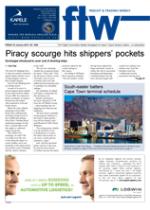When you are assessing
risk factors related to
cargo movement you need
to think like a lawyer,
politician, sociologist,
forwarder, transporter and
more all rolled into one,
according to Sue Wood,
operations director of
Cargocare Freight Services.
“Much of the risk going
forward is due to factors
outside of our control,”
she told FTW, “but the
implications of these
events have to be taken
into account in your risk
management.”
In consultation with
company MD Roland
Raath, a list of major
factors of the moment was
compiled.
“Some new risks are
arising, like global
climate change and piracy
on the Horn of Africa,”
said Wood.
“In terms of climate
change, you have to think
about the last decade of
weather, with things like
tsunamis and higher sea
levels and the risks these
pose to vessels and ports.
“And, apart from the
hijacking of ships off the
coast of Somalia and the
entry to the Gulf, you also
have the potential for piracy
at congested African ports
– where vessels are just
sitting ducks.
“Then there’s the issue
of vessel ageing and safety
standards not being adhered
to. This, of course, has been
heightened due to the global
economic crisis.”
But, while these are
events on the global stage,
Wood emphasised that risk
factors also extended closer
to home.
“These local factors
affecting us include SA
Revenue Service (Sars)
and other government
decisions,” she said, “and
issues arising from policy
determinations by Transnet,
the department of trade and
industry (dti) and Eskom.
“We would also have to
add the local implications of
decisions coming from the
International Air Transport
Association (Iata) and the
SA Civil Aviation Authority
(SACAA) affecting the
global movement of air
cargo to and from SA.”
Wood believes that all
these organisations are
significant pressure points,
and that any changes in
their strategic direction or
regulations can become a
risk to the business.
“You have to keep your
ears to the ground to pick
up on them, and respond
effectively.”
The Cargocare crystal
ball is a bit cloudy this year,
according to Wood.
“I think that a big risk is
going to be the difficulty
of market prediction in
2010,” she added, “probably
even more difficult than
last year.
“But the two biggies
that should really be at the
top of the list would be
HIV and crime, and we’re
addressing both actively.”
The two company
executives also agreed
that another, much more
complex risk for the freight
forwarding industry would
be supply chain integration.
“That is the biggest risk,
but its successful solution
will offer the biggest
reward.”
A long-term, but real
concern that deserves
mention is the whole
oceanfreight scenario,
according to the two
executives.
They are convinced
that global warming and
supply chain developments
will eventually pressurise
international sea cargo
movement downwards,
according to Wood.
“Meanwhile,” she
added, “countries are
building unnecessary extra
port capacity – with a
current global 40% underutilisation
of existing
facilities – and everbigger
ships.
“In this scenario, the
lines are trying like crazy
to reduce their overcapacity
of smaller vessels
that are coming to the end
of their lives. This as they
forecast that demand will
keep dropping – and their
10-year projections are
normally pretty accurate.
“Anyway, that’s one
that’ll come later rather
than sooner – I hope.”
HIV and crime are key risk factors for the decade ahead
22 Jan 2010 - by Staff reporter
0 Comments
FTW - 22 Jan 10

22 Jan 2010
22 Jan 2010
22 Jan 2010
22 Jan 2010
22 Jan 2010
22 Jan 2010
22 Jan 2010
Border Beat
Featured Jobs
New
